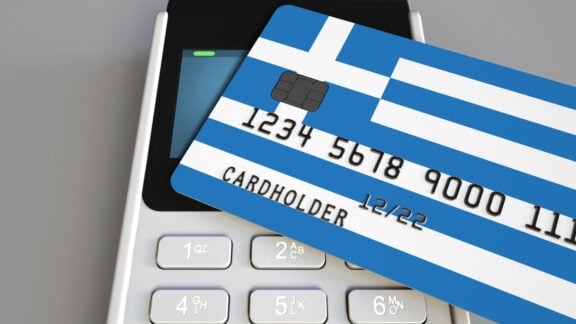One dollar buys… half a euro – after the Australian currency fell in value due to global economic uncertainty following the “tariff war”
The turmoil in the global economy caused by the decisions of US President Donald Trump is having major ramifications everywhere, creating economic challenges that affect everyone, including causing holidays in Greece to become more expensive for Greek Australians.
The hit to global markets as a result of the tariffs has led to a serious weakening of the Australian dollar compared to the euro, which along with the US dollar has automatically become more expensive.
The by-product of that is it drastically impacts travellers and consumers, not as a result of inflation (another consistent factor for price increases) but simply because the exchange rate of the Australian currency (AUD) lost value.
More… plainly?
One euro on Wednesday morning was worth 1.85 Australian dollars, which is up from 1.60 at the end of November last year.
To make it plainer, given many compatriots convert dollars into euros before travelling to Greece or while going there, if they made a transaction on Wednesday (without taking into account other transaction fees) they would get almost half a euro per dollar, or to be precise 0.54 euros compared to almost 0.63 last November.
That value tracks at similar levels to during the COVID-19 pandemic and is only slightly above what it was during the global financial crisis in 2008-2009 when the Australian dollar was at 0.49-0.50 euros.
The Australian dollar has lost 10 per cent against the euro in the last year, but most of that decline has come since late February, when US economic policies, led by tariffs, began to unfold.
That means that everything we pay with Australian money in euros (or US dollars or other stronger currencies) is automatically at least 10 per cent more expensive now.
And as mentioned above, it is not just the products, but also the services.
For example, many young Greek Australians choose to have their wedding (or that of their children/grandchildren) take place in Greece.
Depending on the budget (dollars) they have, they also choose the cost (with pricing in euros).
For example, a couple preparing to get married in early September back in their hometown has seen the cost increase by about 8 per cent in just one week since the announcement of the new round of tariffs.
The tariffs themselves, to be clear, did not directly affect the prices of services provided, but the uncertainty that hit the markets internationally “dropped” the Australian dollar in relation to the euro.
The result is an additional cost of almost $5,000 for a wedding, all in the span of just a few days.
Unfortunately, the consequences will be similar for everything that is paid in euros and invoiced in euros.
This includes, pending further accuracy, imported products from Greece (Europe and the US in general), provided of course that the “weakness” of the AUD continues.
Other services that will be impacted include accommodation, car rentals, excursions and much more.
Those who can afford it – and especially those who have already booked tickets for their vacation in Greece – will most likely not back down due to the exchange rate.
Those who have not pre-paid for services will not be affected (much), at least until they set foot in the country (and until then… we’ll see what happens with the dollar and the euro).
But even they may try to limit the money they spend by having a specific budget.
Visitors from Australia have been known for years to go to Greece… and they understand, often making the biggest “bill”.
Since last year, however, at least according to data from the Bank of Greece, there has been a significant decline in spending by travellers from the Antipodes (the majority of whom, as is known, are fellow countrymen).
The average cost per trip (excluding tickets) decreased in 2024 to approximately 1,068.5 euros ($1,800), compared to 1,594.4 euros in 2023 (almost 2,700 dollars)*.
The exchange rate was at 0.60 euros to every dollar for a long period last year during the Greek summer.
Indicatively, the average expenditure per trip was 1,430.2 euros in 2022 and 1,060.7 euros in 2021 (with the pandemic still causing problems).
The cost-of-living crisis in Australia, as well as the relatively low exchange rate, seems to have significantly affected the amount spent, on average, by Australian travellers in Greece.
For 2024, according to the Bank of Greece, the most money, per trip, was spent by visitors from Canada (1,260.1 euros), who were in second place in 2023, after Australians (with spending of 1,028.3 euros compared to 1,594.4 as mentioned above).
There was a similar reduction in overnight expenses (travel expenses divided by the days of stay).

Visitors from Australia spent 92.4 euros per day in Greece (approximately $155) on average, a significant drop compared to 131.9 euros in 2023 and 110.4 euros in 2022.
As a result, last year, visitors from Russia came first in travel spending per night (119.8 euros), in second place were those from the USA (107.2 euros), and in third place were those from Spain (99.9 euros).
They were followed by: Canada (95.6 euros), United Kingdom (95.1) Austria (94.8 euros), Switzerland (94.2 euros), Albania (93.4 euros) and Australia (92.4 euros).
Even if a traveller from Australia spends the same amount as last year, their purchasing power (based on the current exchange rate of 0.54 euros) will be reduced by 5 cents per dollar compared to 2024.
That is, the 155 dollars last year instead of 92.4 euros will “get” 83.7 euros or 8.7 euros less.
Historically, based on the exchange rate, the best time for Australians to vacation in Greece was the summer of 2012 when, with the eurozone in the midst of a crisis, 1 Australian dollar “bought” 0.85 euros.
But the summers of 2015-2017 weren’t bad either when the exchange rate was at 0.70, a value it also reached in August 2022.
Fuel
And within the borders, however, with the Australian dollar… low, goods imported by Australia tend to automatically become more expensive.
For example, fuel, as prices are set in US dollars (USD).
The AUD exchange rate against the USD also hit a 5-year low, with one Australian dollar worth almost 0.60 of one US dollar, while it recently recorded its biggest daily drop in 17 years.
Recently, there has been a decrease in the price of gasoline, with drivers in Australia saving a lot of money on each fill-up.
On the positive side, crude oil prices remain at three-year lows as concerns about global growth due to tariffs weigh on demand expectations, with Brent trading at $64.70 a barrel.

Super
The balances of pension funds (Superannuation) have also suffered a blow, not because of the exchange rate, but because of the broader turmoil in international markets, as their performance depends on stock market returns.
The Funds warn, however, that there is no need to panic.
In particular, according to the AAP, the Super Members Council urged its members not to move their money to other investments following the “short-term market decline” as there is a “potential” for them to miss out on a subsequent recovery in value.
“Super is a long-term investment,” said executive general manager Matthew Linden.
“We expect this week’s market declines to have little impact in 20 years – and beyond – when most of today’s super fund members will start thinking about retirement.”
Australians may be right to be concerned about the state of the economy and the balances of their superannuation funds, commented, for his part, IG market analyst Tony Sycamore.
“I would describe it as something that is very much on the brink of collapse,” Sycamore told AAP.
“We’re looking further ahead. There is (a possibility of) a recession… there is a liquidity crisis.”
Federal Treasurer Jim Chalmers stressed that Australia is uniquely positioned to weather the “economic storm”.
New Treasury models that account for the impact of US policies as much as possible predict that Australian GDP will be 0.1 per cent lower and inflation will be 0.2 per cent higher in 2025.
Australia’s GDP is estimated to be lower in the medium term – mainly as a result of indirect effects from reduced export demand from Asia – while the increase in inflation is considered temporary.

“What we are seeing here is the impact of a series of bad decisions that were made regarding tariffs,” Chalmers said.
“And the whole world is trying to realize the impacts on their own economies and on the global economy.”
Prime Minister Anthony Albanese acknowledged that this is a situation that is causing concern among citizens.
“We are seeing a significant impact, negative, on the stock market,” he said.
“This affects Australians because superannuation funds have their shares there.”
Sycamore said that “if you have a few years ahead of you, like many Australians, you’re probably not that worried.”
Someone in the 30 to 50 age group is likely to see their balance take a heavier hit, but past experience suggests they are likely to recover by the time they enter their retirement phase.
Opposition Leader Peter Dutton, for his part, went on the “attack”, arguing that the Coalition has a proven track record of handling global economic shocks, such as after September 11 and amid the COVID-19 pandemic.
“In uncertain times, our country needs strong economic management,” he pointed out.
“In this election campaign, the choice is about who can best manage our economy to help you move forward.”
*The information provided is for general informational purposes only and should not be considered personalised financial advice. Please consult a professional before making any investment decision.
With AAP









